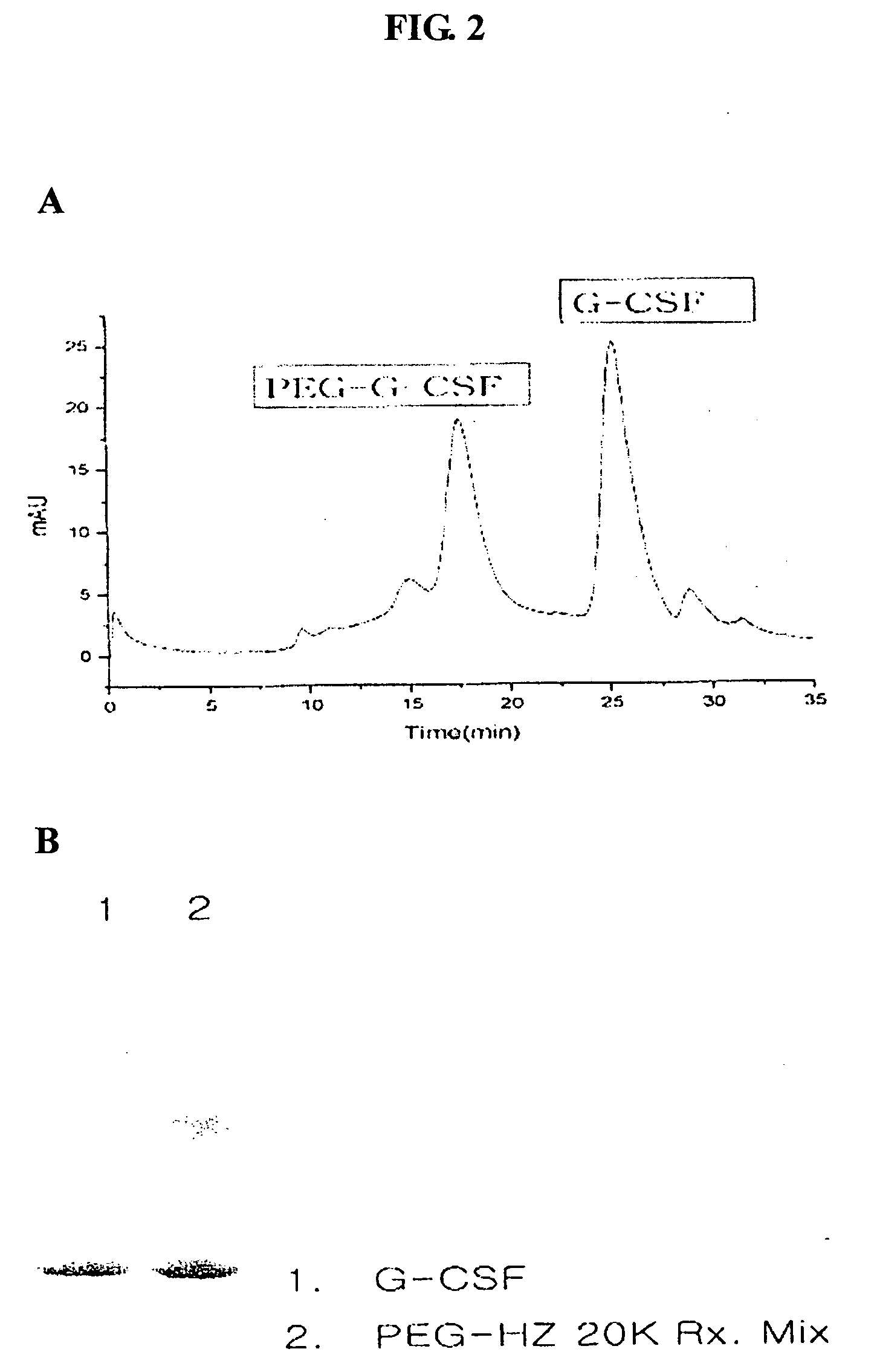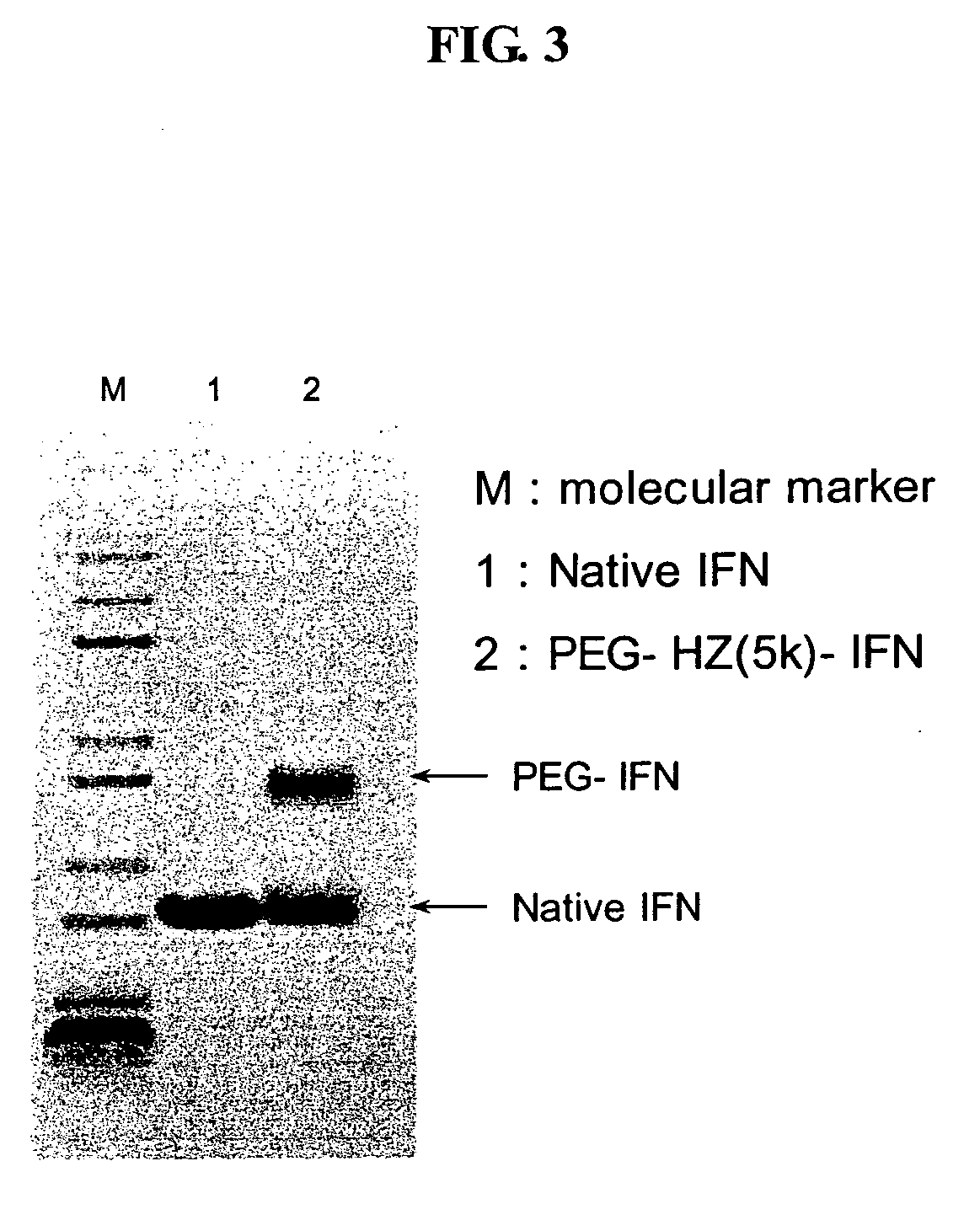Human growth hormone conjugated with biocompatible polymer
a technology of growth hormone and polymer, which is applied in the field of human growth hormone conjugated with biocompatible polymer, can solve the problems of reducing the biological activity of the peg-protein conjugate, the form of hgh is not as effective in accelerating the growth rate of children, and the conjugation method is not known, so as to achieve the effect of reducing the lean muscle, increasing the blood pressure, and increasing the cholesterol
- Summary
- Abstract
- Description
- Claims
- Application Information
AI Technical Summary
Problems solved by technology
Method used
Image
Examples
example 1
Preparation of mPEG (12000)-Hz-G-CSF Conjugate
[0129] 1 mg of G-CSF solution (0.00005 mmol, Dong-A Pharm. LEUCOSTIM) was dialyzed (Centricon-10, Amicon, USA) against 50 mM MES buffer solution (pH 3.0) to the final concentration of 2 mg / ml. To this protein solution, 6.6 mg of mPEG(12000)-hydrazide (Hz) (ISU Chemical, Korea, 0.0005 mmol) was added and followed by 2 ul (0.001 mmol, 20-fold molar excess) of EDAC solution prepared by dissolving 2 mg of EDAC in 20 ul of d-H2O. The reaction was carried out for 1 hour at room temperature (20-25° C.) with stirring. After 1 hour, unreacted G-CSF and excess reagent were removed by size exclusion column or ion-exchange column. More than 0.3 mg of mPEG(12000)-Hz-G-CSF conjugate was obtained. By changing the amount of EDAC from 20 to 200-fold molar excess and mPEG(12000)-Hz from 10 to 20-fold molar excess, the reaction was repeated. It was observed that two or more mPEG(12000)-Hz were attached to the carboxyl group of G-CSF when the amount of EDA...
example 2
Preparation of mPEG(5000)-Hz-G-CSF Conjugate
[0130] 1 mg of G-CSF solution (0.00005 mmol) was dialyzed (Centricon-10, Amicon, USA) against 50 mM MES buffer solution (pH 3.0) to the final concentration of 5 mg / ml. To this protein solution, 1.3 mg of mPEG(5000)-Hz (ISU Chemical, Korea, 0.00025 mmol) was added, followed by 2 ul (0.001 mmol, 20-fold molar excess) of EDAC solution prepared by dissolving 2 mg of EDAC in 20 ul of d-H2O. The reaction was carried out for 1 hour at room temperature (20-25° C.) with stirring. After 1 hour, unreacted G-CSF and excess reagent were removed by size exclusion column or ion-exchange column. More than 0.3 mg of mPEG(5000)-Hz-G-CSF was obtained. FIG. 1 shows the production of mPEG(5000)-Hz-G-CSF conjugate by SDS-PAGE and HPLC profile (size exclusion chromatography).
example 3
Preparation of mPEG(20000)-Hz-G-CSF Conjugate
[0131] 1 mg of G-CSF solution (0.00005 mmol) was dialyzed against 50 mM MES buffer solution (pH 3.0) by ultrafiltration (Centricon-10, Amicon, USA) to the final concentration of 5 mg / ml. To this protein solution, 5 mg of mPEG(20000)-Hz (ISU Chemical, Korea, 0.00025 mmol) was added, followed by 2 ul (0.001 mmol, 20-fold molar excess) of EDAC solution prepared by dissolving 2 mg of EDAC in 20 ul of d-H2O. The reaction was carried out for 1 hour at room temperature (20-25° C.) with stirring. After 1 hour, unreacted G-CSF and excess reagent were removed by size exclusion column or ion-exchange column. More than 0.3 mg of mPEG(20000)-Hz-G-CSF, was obtained. FIG. 2 shows the production of mPEG(20000)-Hz-G-CSF conjugate by SDS-PAGE.
PUM
| Property | Measurement | Unit |
|---|---|---|
| pH | aaaaa | aaaaa |
| molecular weight | aaaaa | aaaaa |
| molecular weight | aaaaa | aaaaa |
Abstract
Description
Claims
Application Information
 Login to View More
Login to View More - R&D
- Intellectual Property
- Life Sciences
- Materials
- Tech Scout
- Unparalleled Data Quality
- Higher Quality Content
- 60% Fewer Hallucinations
Browse by: Latest US Patents, China's latest patents, Technical Efficacy Thesaurus, Application Domain, Technology Topic, Popular Technical Reports.
© 2025 PatSnap. All rights reserved.Legal|Privacy policy|Modern Slavery Act Transparency Statement|Sitemap|About US| Contact US: help@patsnap.com



